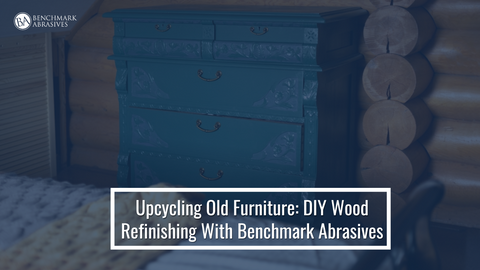
Upcycling Old Furniture: DIY Wood Refinishing With Benchmark Abrasives

Have you given upcycling furniture? Upcycling may be a terrific way to update some worn-out pieces or even assist in livening up a room, especially in light of the increasing emphasis on environmental responsibility and the fact that many of us are tightening our purse strings. Who wants to spend hundreds of pounds on a new piece of furniture when all it needs is some little repairs?
How do you do it now that you're prepared to start upcycling wooden furniture? To get you going, we're giving you our best advice!
STEPS IN UPCYCLING OLD FURNITURE
1. SELECT YOUR ITEM
Whether you're looking to upcycle garden furniture for the summer or pine furniture for your bedroom, plenty of ideas for upcycled furniture are available. You already own a table that needs some color, or you're searching for a new chair to make your space come together. Before you work on it, confirm that the piece is still structurally sound, regardless of whether you already own it or want to add it to your collection of upcycled wood furniture. Avoiding wooden objects with holes is advised, as woodworms may cause them.
2. SET UP YOUR WORKSPACE
After obtaining the furniture, you must arrange it. You'll need room and adequate ventilation, so consider your workstation options carefully. After you're done, you might need to clean up, so throw down some dust sheets to shield anything you wish to save! It is advisable to wear safety gear such as dust masks, goggles, and gloves.
3. SANDERS READY
This is the most crucial stage since it involves removing the previous layers so that your brand-new furniture can be seen. Not all sandpaper is created equal, so you must select the appropriate grit for each application stage. Sand the piece's edges gently toward the wood grain using aluminum oxide or general-purpose sandpaper with a medium grit (such as 80). The same sandpaper, but in coarser (60 grit) form, is what you'll need if you're working on a previously painted piece because it can cut through paint.
Try to work evenly if you want the result to be exceptionally smooth. To provide a smooth surface for painting, you must use high-quality abrasive finishing paper (320 grit, for example) to cover the entire piece. Sanding sponges are helpful for flat, angled, or contoured surfaces that are difficult to reach and require a flawless finish.
Before proceeding to the following steps, use a brush to remove all the dust.
4. CHOOSE YOUR PAINT
Paint is a great way to update and give furniture life. Before applying paint, you could start with a primer once you have an excellent surface. Recall that after the primer dries, you'll need to sand it down (you can use the same sanding supplies you used in step 3). The next step is to add some color! Use a paintbrush to apply it evenly (or a roller if it's a large piece), and wait until it dries completely before applying a second coat. Selecting the ideal paint for upcycling furniture can impact the finish; gloss gives a glossy sheen, while chalk paints are famous for leaving a matte, rustic effect. Use testers to determine the optimum finish before committing.
5. SHABBY CHIC
Want to paint repurposed furniture in a shabby chic style but need to know how? Sanding is the final step after painting the furniture. You can use super fine finishing sandpaper or even 320g or higher wet and dry paper to carefully remove the paint from the surface. Avoid taking on the entire piece—less is more! Concentrate on the sections most likely to show signs of wear under typical use, such as the handles or the edges, and experiment with different grits in different places to achieve a more realistic look. Sand frequently in the same direction to achieve the desired finish.
6. WAXING LYRICAL
Once you've achieved the desired look, you must safeguard your creation. If you are satisfied with a high-shine finish, you can varnish the furniture instead of applying a layer of soft clear wax with a soft, lint-free cloth. To help you enjoy your new artwork for longer, use both of these to seal and protect the paint!
CONCLUSION
And there you have it—a simple tutorial on upcycling furniture for beginners! We provide an array of options to assist with your upcycling furniture ideas, including worn-out kitchen cupboards, if you're prepared to get started and require the appropriate sanding tools.



































































